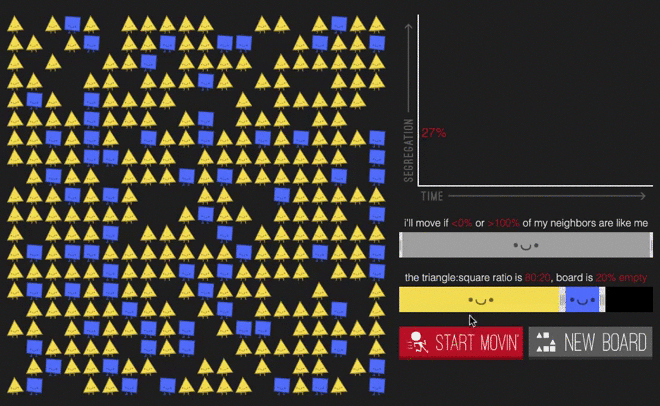Shapism vs anti-shapism.
Is anti-shapism the antidote to shapism, or just another form of shapism?
Parables about shapism tend to assume that both shape communities are equal in number. For example, Dr. Seuss’ Sneetches have an equal number of Plain and Star-Bellied Sneetches, and Parable of the Polygons defaults to an equal number of Squares and Triangles. But I got to wondering if the lessons of those parables remain applicable in the real world, where there is a majority shape and a minority shape.
Fortunately, Parable of the Polygons contains a “big ‘ol sandbox” at the bottom to adjust multiple parameters. It starts with an equal number of triangles and squares,
and demonstrates that segregation increases very quickly when shapes have even a small bias toward living near shapes like them, and segregation quickly decreases when they have even a small bias toward neighbors with shape diversity. Shape-bias bad. Anti-shape bias good. Lesson learned. Kumbaya and Shape Justice.
But, when you change the ratio to be 80% triangle versus 20% squares, e.g.:
the outcome becomes a lot more complicated. In fact, there really is not an outcome, just a continuous churn of unhappy shapes, forever and ever:
What is responsible for this endless churn of unhappiness. Is it shapism, or anti-shapism (both of which exist in the default setting)? To answer this question, I first included only the shapist bias parameter, so that any shape will move if less than 20% of it’s neighbors are “like me”:
which results in a society that soon became stable with happy (albeit segregated) shapes:
Next, I included only the anti-shapist parameter, so that any shape will move if >80% of its neighbors are “like me” (i.e. so that all shapes “value diversity”):
which leads to an initial small drop in segregation, and then a neverending instability as shapes compete in an endless struggle to prove they are more anti-shapist than their neighbors:
Since it turns at that shapism is a problem, and anti-shapism is a problem, what alternative is there for social harmony? How about neither shapism nor anti-shapism? How about not caring a damn about shape, a.k.a. “shape blindness”. To test this, I turned off both the shapist and anti-shapist parameters:
Giving this simulation:
Did you see that (it’s easy to miss if you blink)? Nothing happened! Everyone is happy, nobody wants to move because nobody cares WTF shape their neighbor is. Shapism is solved by NOT CARING! Yes, you have diversity—but, ironically, by not caring about diversity.
Turns out the old folks were right. The answer to Shapism is Shape Blindness.
Next week on Shape Warriors: Bias in the mattress industry! Why are there so few mattresses designed for triangle-shaped bodies.










